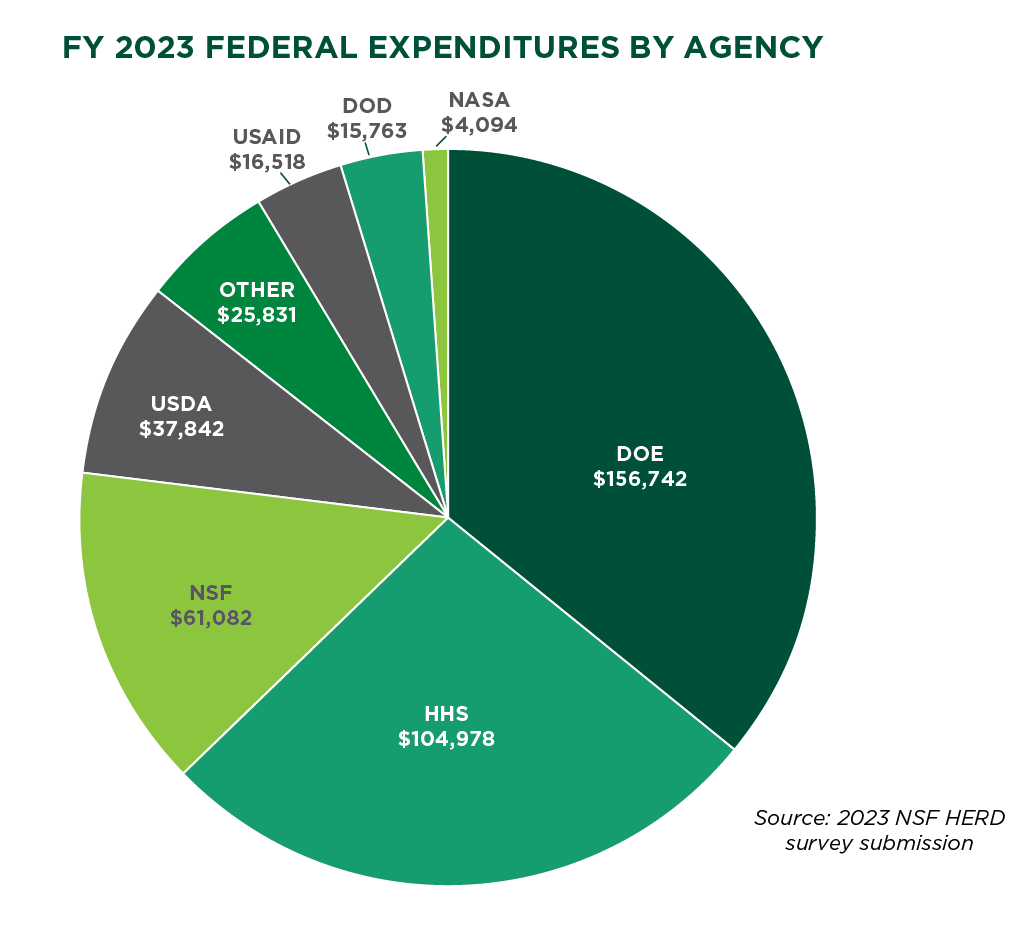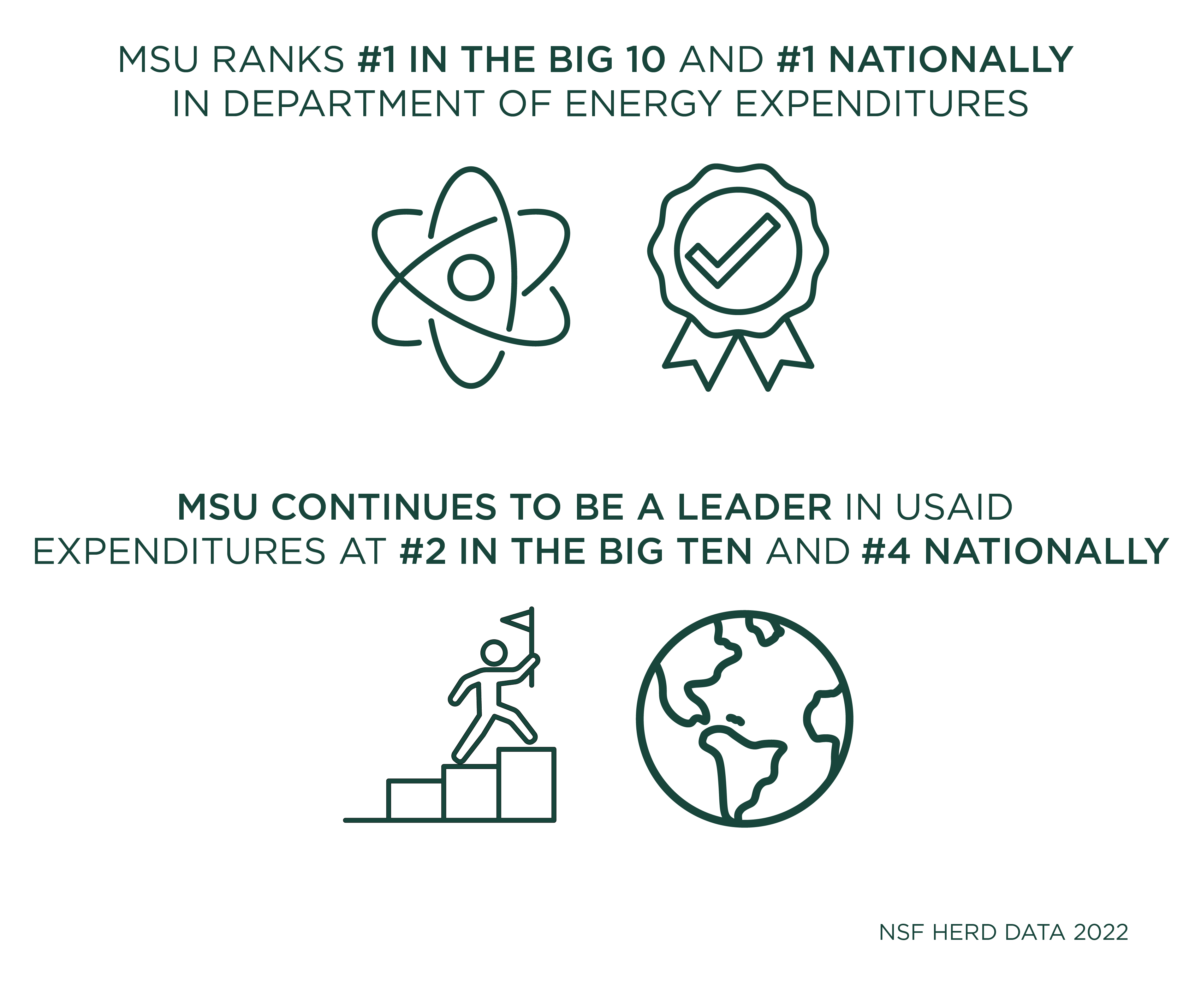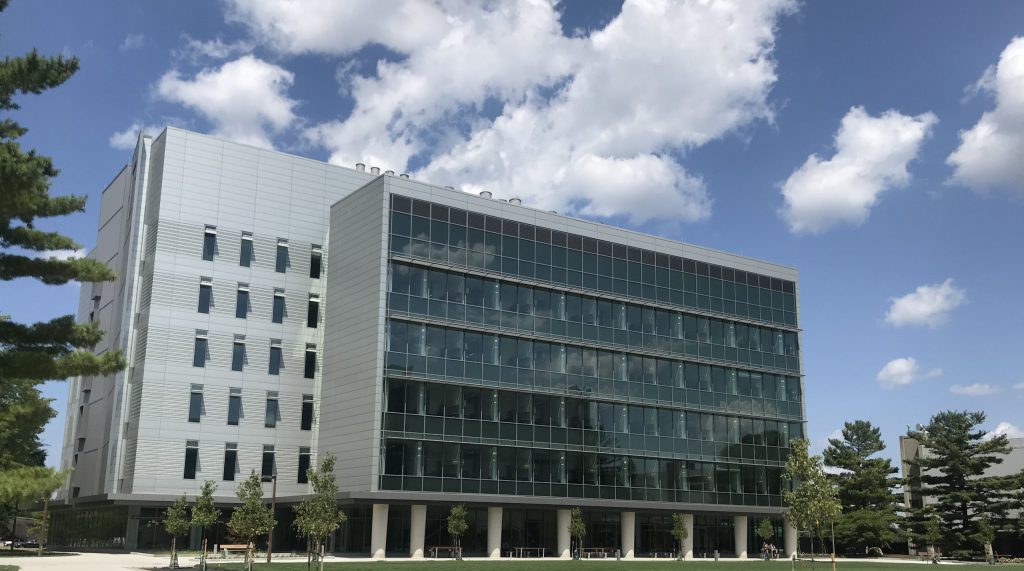Facts & Figures
Research Expenditures
Research expenditures – that is, the funds spent to conduct research – are the most frequently cited numbers for comparing research levels among colleges and universities. The National Science Foundation (NSF) surveys all recipients of federal funds annually, asking about their research expenditures from all funding sources. MSU has participated in that survey since 1998. The NSF numbers constitute the most comprehensive listing of research expenditures and provide consistency for comparison with other institutions.
The Michigan State University research enterprise has experienced strong growth over the past decade as exhibited in the total research and development expenditures chart.
MSU's total research expenditures were $844 million for FY2023, and Federally funded research expenditures were $436 million.

Top federal funding agencies: Department of Energy, Department of Health and Human Services, National Science Foundation, Department of Agriculture (USDA), U.S. Agency for International Development, and the Department of Defense.
MSU ranks #1 in the Big 10 and #1 nationally in Department of Energy expenditures.
Major contributors include the MSU and U.S. Department of Energy-funded Facility for Rare Isotope Beams (FRIB) as well as the MSU-DOE Plant Research Laboratory, the Great Lakes Bioenergy Research Center and several other interdisciplinary and multi-institutional research projects that are DOE funded.
MSU continues its leadership in USAID expenditures at #2 in the Big Ten and #4 nationally.
Source: NSF HERD 2022 Data

Research Funding
Funding for externally sponsored programs comes primarily from federal agencies, state agencies, industry, associations, and foundations. Competitive internal grants programs and Facilities and Administrative (F&A) cost return also support research. Funds for conducting research are generally awarded in multi-year contracts or grants, therefore the amount recorded as received each year may not reflect the research being done in that year.
For additional facts and figures about the MSU research enterprise, or statistics about the university, please review the Data Digest or Planning Profile Summary, produced by the MSU Office of Planning and Budgets.
Innovation and Tech Transfer
The MSU Innovation Center stewards scientific and creative discoveries into a pipeline of patents, products and startup businesses. In FY2023, the MSU Innovation Center recorded 141 invention disclosures, and 60 new patent applications along with 44 US issued patents. Productivity resulted in $25.2M dollars in corporate support for research projects. Additionally, $4.4M in income from licenses was generated through royalties distributed back to MSU faculty and departments.
University Rankings
Michigan State University is a top global research university. The MSU Office of Planning & Budgets tracks several ranking outlets comparing undergraduate and graduate programs, and global university research rankings. Global rankings include US News, Times Higher Education, Shanghai, and Quacquarelli Symonds. Visit the comparison page to view:
Top Faculty
The university attracts and welcomes an international community of outstanding graduate students, postdoctoral associates, and faculty visitors to a broad range of highly ranked graduate programs, research centers, and interdisciplinary collaborations. As of Fall 2020, approximately 5,300 faculty and academic staff with 1,885 tenure-stream faculty were among our community of scholars.
- MSU boasts 10 members of the National Academy of Sciences (eight of whom are plant scientists) four members in the National Academy of Engineering, and one in the National Academy of Medicine. Note: some are emeritus.
- MSU has seven members in the American Academy of Arts and Sciences.
- Other notables include Guggenheim, Packard, and Sloan Fellows, Pulitzer Prize and Grammy Award winners, and one recipient of the World Water Prize.
- Learn more on the Faculty Recognition page and also see the Honored Faculty website.
New Infrastructure
The Facility for Rare Isotope Beams (FRIB)—a $730M scientific user facility funded by the U.S. Department of Energy Office of Science, MSU, and the state of Michigan—will advance nuclear physics and provide research opportunities for scientists and students from around the globe. FRIB opened in spring 2022, ahead of schedule and on budget.
IceCube is the world’s largest neutrino detector, using a billion tons of the Antarctic ice cap beneath the U.S. Amundsen-Scott South Pole Station to observe neutrinos. It is operated by a collaboration of 300 physicists from 48 universities and national laboratories in 12 countries. MSU is a major participant in this NSF research facility and will help lead an NSF-funded $300M expansion.

The Interdisciplinary Science and Technology Building opened in August 2019.
New in 2016, the Institute for Quantitative Health Science and Engineering (IQ) aims to foster collaboration among the sciences on campus and beyond, creating endless possibilities for transforming patient care with new biomedical discoveries. IQ has grown to more than 36 faculty in 16 departments (six colleges) with additional affiliated faculty across campus. MSU recruited IQ director Chris Contag from Stanford and Precision Medicine chair Anna Moore from Harvard.
The new Interdisciplinary Science and Technology Building opened in August 2019, is a neighbor to IQ, and together with Life Sciences, Radiology, and the Clinical Center, forms a dedicated biomedical research complex on south campus. It currently houses the Precision Health Program among other interdisciplinary groups.
McLaren Health Care's new hospital facility on the campus of MSU opened in early 2022. The comprehensive health care campus is home to more than 1,000 physicians, researchers, educators and other members of the academic and medical team.
Grand Rapids Research Center was completed in 2017 with space for 44 research teams in translational science and molecular medicine, pediatrics, and OBGYN. An additional building next door recently broke ground for expanded research collaborations with Spectrum Health, the Van Andel Institute and others.
Launched in 2015, the department of Computational Mathematics, Science, and Engineering or CMSE was planned, authorized, and operational in only three years. CMSE is unique among computational academic units nationally - it is focused on data science, machine learning, advanced computation and related applications, but is not a traditional CS department. It supports many of the new efforts on campus that require the analysis of large data sets and development of new tools and algorithms.
The MSU Libraries and the College of Arts & Letters partnered to build a state-of-the-art Digital Scholarship Lab, opened in February, 2018. The 10,000-square-foot space features a 360-degree immersive visualization room, graphics-intensive computing software and interactive visualization for research projects and scholarly exploration.
The Plant Resilience Institute was formed in 2016 under the Global Impact Initiative. Its mission is to enhance plant resilience to environmental challenges including extremes in weather and climate change, and to become a “Center of Excellence” for foundational and translational plant research aimed at increasing the productivity and quality of food and energy crops.
The Minskoff Business Pavilion, opened in fall 2019, will enhance the Broad student experience through its design around community, collaboration and teamwork. The space provides resources for research, innovation and the development of transformational business leaders.
The Billman Music Pavilion in the College of Music opened in 2021. The new facility and renovated space in the Music and Music Practice buildings will enhance student learning with advanced acoustical engineering and custom designed spaces within a climate-controlled environment.
